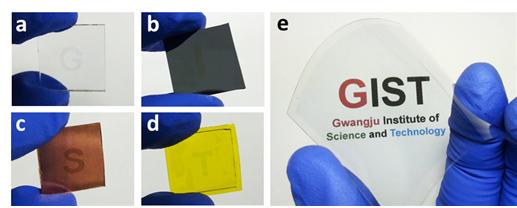Media Center
A multimedia mosaic of moments at GIST
GIST Excellence
[Press Release] Prof. Kwanghee Lee"s Team Develops Novel Transfer-Printing Technique for Transparent Electrodes
- 정명식
- REG_DATE : 2015.04.27
- HIT : 784
Study Hoped to Fasten Advent of IoT (Internet
of Things) Era by Enabling Plastic Transparent Electrodes
on Any Desired Surface via Simple Stamping

A Korean
research team has developed a novel method of transfer-printing plastic transparent
electrodes, which have both low cost and
high performance, onto arbitrary surfaces via simple stamping. Through the
versatile integration of high-performance flexible transparent electrodes (FTEs)
with other device components, such as flexible devices and adhesive sensors,
their
research is expected to accelerate the arrival of the Internet of Things era.
The research was led by corresponding
author Prof. Kwanghee Lee of GIST School of Materials Science and Engineering
and by co-first authors Mrs. Nara Kim, a doctoral student at GIST School of
Materials Science and Engineering, and Dr. Hongkyu Kang of the Research
Institute for Solar and Sustainable Energies (RISE). This work was supported by
a grant from the National Research Foundation of Korea, funded by the Ministry
of Science, ICT and Future Planning. The result was published online on April 8,
2015 in Advanced Materials (Title: Highly Conductive All-Plastic
Electrodes Fabricated Using a Novel Chemically Controlled Transfer-Printing
Method).
Conducting plastics (CPs) have been
considered a promising candidate for FTEs to replace conventional transparent
electrodes based on brittle and expensive indium tin oxide, due to their
mechanical flexibility and low-cost solution processability. However, the
necessity of applying a harsh treatment using sulfuric acids to enhance the
electrical conductivity of CPs up to that of ITO makes these cost-effective and
high-performance FTEs unsuitable for application to most underlying layers,
including typical plastic substrates, which would be destroyed by the requisite
strong acid treatment.
The research
team developed a facile method of transfer-printing the highly conductive
plastic FTEs onto arbitrary surfaces, including typical plastic substrates, by controlling
the adhesion between plastic films and substrates. While the conventional
transfer-printing methods rely on etching the donor substrates for the
detachment of the donor-film interface to “ink” an elastomeric stamp with the
film, the novel transfer-printing method based on the chemically controlled
adhesion at the donor-film interface enabled the simple process of bringing the
stamp into contact with the highly conductive plastic films on the donor
substrates and lifting the stamp away to
produce a stamp that is fully “inked” with the high-performance plastic FTEs, which
is then readily available for transfer-printing onto arbitrary surfaces by using
thin adhesive layers. The plastic FTEs transferred onto various surfaces
exhibited a high visible-range transmittance of 90% and a low sheet resistance
of 45 Ω/sq.
Prof. Lee
said, “Our simple and low-cost manufacturing method for high-performance
plastic electrodes on arbitrary surfaces is expected to expand the scope of
applications of FTEs for the realization of next-generation ubiquitous
electronic technologies, including wearable devices, transparent displays,
adhesive sensors, and transparent antennas, in the coming era of the Internet of
Things.”
